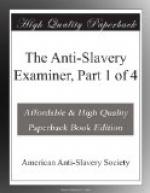(d.) The new moons. The Jewish year had twelve; Josephus says that the Jews always kept two days for the new moon. See Calmet on the Jewish Calendar, and Horne’s Introduction; also 1 Sam. xx. 18, 19, 27. This in forty-two years, would be two years 280 days.
(e.) The feast of trumpets. On the first day of the seventh month, and of the civil year. Lev. xxiii. 24, 25.
(f.) The atonement day. On the tenth of the seventh month. Lev. xxiii. 27.
These two feasts would consume not less than sixty-five days not reckoned above.
Thus it appears that those who continued servants during the period between the jubilees, were by law released from their labor, TWENTY-THREE YEARS AND SIXTY-FOUR DAYS, OUT OF FIFTY YEARS, and those who remained a less time, in nearly the same proportion. In this calculation, besides making a donation of all the fractions to the objector, we have left out those numerous local festivals to which frequent allusion is made, Judg. xxi. 19; I Sam. ix. etc., and the various family festivals, such as at the weaning of children; at marriages; at sheep shearings; at circumcisions; at the making of covenants, &c., to which reference is often made, as in 1 Sam. xx. 28, 29. Neither have we included the festivals instituted at a later period of the Jewish history. The feast of Purim, Esth. ix. 28, 29; and of the Dedication, which lasted eight days. John x. 22; 1 Mac. iv. 59.
Finally, the Mosaic system secured to servants, an amount of time which, if distributed, would be almost ONE HALF OF THE DAYS IN EACH YEAR. Meanwhile, they were supported, and furnished with opportunities of instruction. If this time were distributed over every day, the servants would have to themselves nearly one half of each day.
THIS IS A REGULATION OF THAT MOSAIC SYSTEM WHICH IS CLAIMED BY SLAVEHOLDERS AS THE PROTOTYPE OF AMERICAN SLAVERY.
V. The servant was protected by law equally with the other members of the community.
Proof.—“Judge righteously between every man and his neighbor, and THE STRANGER THAT IS WITH HIM.” “Ye shall not RESPECT PERSONS in judgement, but ye shall hear the SMALL as well as the great.” Deut. i. 16, 17. Also Lev. xxiv. 22. “Ye shall have one manner of law as well for the STRANGER, as for one of your own country.” So Numb. xv. 29. “Ye shall have ONE LAW for him that sinneth through ignorance, both for him that is born among the children of Israel and for the STRANGER that sojourneth among them.” Deut. xxvii. 19. “Cursed be he that PERVERTETH THE JUDGMENT OF THE STRANGER.”




